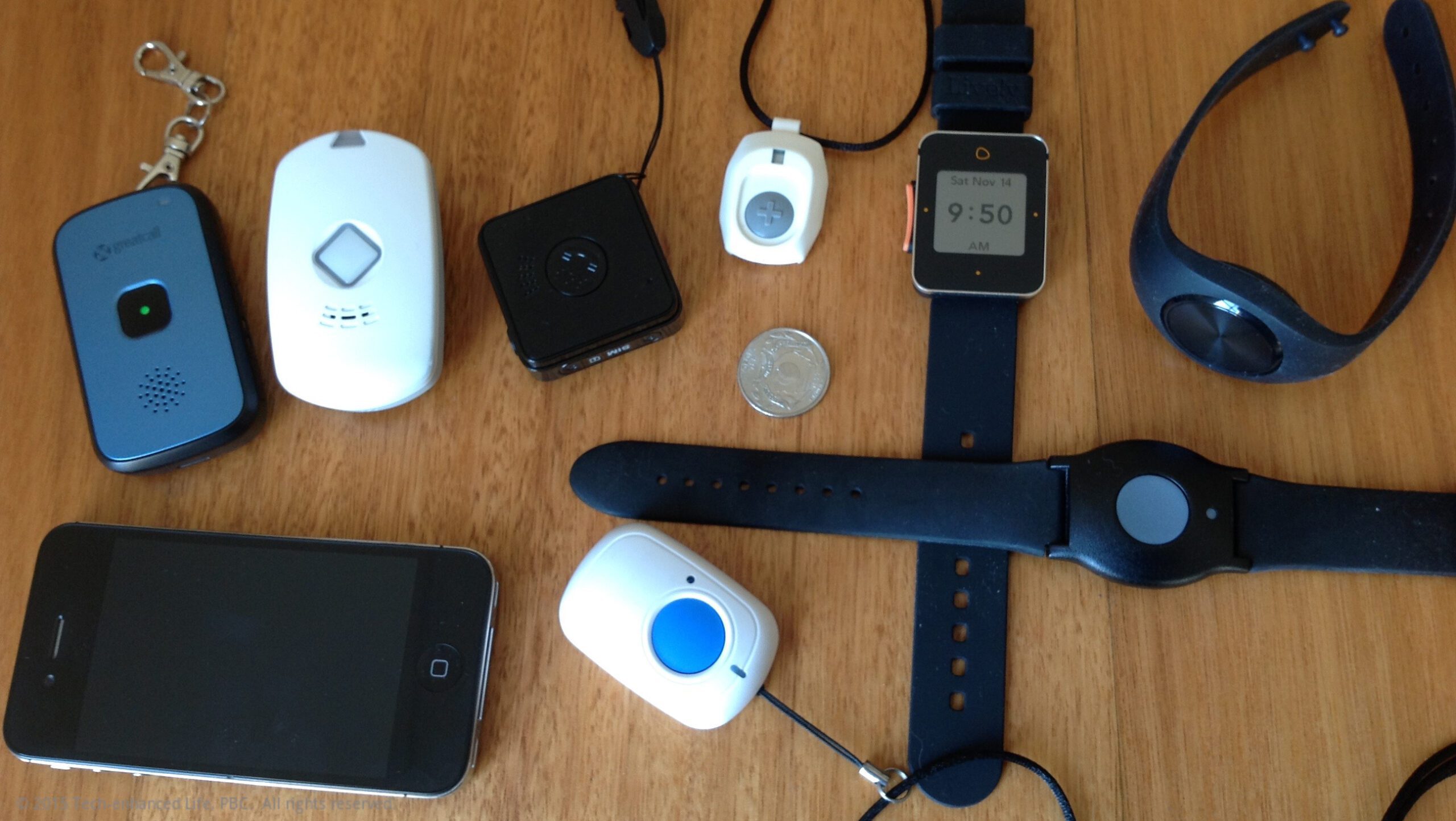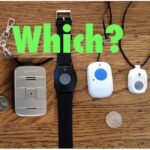By: Editorial Team | Posted: December 19, 2023 | Updated: February 12, 2025
Medical Alert Systems are conceptually simple. You press a button and help comes.
But when it comes down to choosing one, it turns out there are quite a few subtleties that one needs to take into account to be sure of choosing the best medical alert for a given person.
This site includes various reviews and articles about different medical alerts. To get the most out of reading the material, you really need to know which types of features you actually want.
This Learning Module contains several different pieces of content designed for people with different levels of familiarity with the topic of personal emergency response systems.
It consists of:
- a recorded lecture on medical alerts, and
- a tutorial on the basics.
Lecture & Workshops
When we first developed this medical alert learning module we created a rather detailed online workshop.
However, we have found people prefer either:
- (a) an actual hands-on, face-to-face workshop; or
- (b) a lecture they can watch at their convenience.
If you represent a group that wants either a face-to-face workshop or an in-person lecture, feel free to reach out and explore the possibilities.
- Contact us to explore a workshop or lecture to your community.
- To watch a recorded lecture, read on.
Recorded Lecture
For most readers, a recording of a lecture (with slides) is a great way to get an overview of the medical alert system topic.
Here is a relatively recent video recording of a lecture on medical alerts given by Dr. Richard Caro in 2022.
View and Listen to the Seminar
Abstract
Medical Alerts are well known “safety” devices. However there are many different types, and there are very few resources to help decide which type is best. Tech-enhanced Life has for years been evaluating different products in this category. While we do not believe there is such a thing as a “best” medical alert, we do think there are often a handful of “best” products for specific individuals (the right features depend on lifestyle).
In this talk, we will explain how to decide which type of medical alert is right for a specific person, and introduce you to the detailed coverage on Tech-enhanced Life that will enable you to pick a specific product that works for the person in question.
Deep-Dive Articles Mentioned in the Talk
Medical Alert Systems Guide (The “Hub”)
Tutorial: The Basics
An Emergency Response System (medical alert system) includes some type of button you press, or automatic sensor that detects you have a problem. When you press the button or the problem is identified, the system somehow sends a message to a “responder” and then that responder takes some action.
The Responder
There are quite a few different approaches to how these systems are implemented. In the most common approach the “responder” is a call center operated by or on behalf of the company that makes the medical alert system. So when there is an emergency, the system “calls” the call center where there is a person whose job it is to take action. This approach is called a “monitored” system.
There are also systems that are “unmonitored“. In that case, you set them up so that in emergency the system calls a number you tell it in advance, or sends an email to people you designate in advance. The typical scenario is that you program it to call a friend or family. Or perhaps 911. Or perhaps an escalating call tree, starting with friends and then going to 911 if no-one answers.
What Happens in Emergency
When an emergency is detected (most typically when you press the button on the alert system), the system calls the responder. Some responders will just send emergency services right away (ie dial 911). But the more sophisticated responder services will call the older adult who is having an emergency and try and find out what is going on before taking further action.
Ideally, the older adult gets a call from a responder who says “Are you OK Mrs Smith? How can we help you?”. Some services will provide a range of response services. For example they might call the towing company if you have broken down, or call an ambulance in a real emergency, or just stay on the phone while you walk through a bad neighbourhood if you are feeling unsafe.
Fall Detection Algorithm
As of Jan. 2024 when this was last updated, many medical alerts incorporate a fall detection algorithm.
This is in our opinion an important feature. The way it works is that there is a sensor built in to the product that can detect if you fall over. When it detects a fall it first asks you if you fell and if you are OK. But if you don’t respond it automatically calls for help, in the same way it would if you pressed the button.
This is a very important feature if you worry about falling and hitting your head, or having some type of cardiac event or stroke then falling.
Of course, these algorithms are not perfect, and sometimes lead to false alarms. Thus it is important to get one of the products that include the ability to talk to you and check it is a “real” fall.
The Sensor / Button / Wearable
A medical alert system is only useful if it can actually summon help in an emergency. Typically, these systems have some type of pendant or wrist-worn device that has a button on it. The older adult is supposed to press the button in case of emergency.
Some pendants are designed to include a fall autodetection capability, and can automatically contact the responder when they detect a fall. One needs to consider what happens in case of a false alarm for one of these automatic systems.
A modern approach to designing a medical alert system is to make the whole system an “App” on a smart phone. In this case, instead of a pendant you just need to press the button on your smartphone.
The ergonomics and cosmetic appeal of the sensor/button/wearable is critical, and what works for one person may not be right for another. After all, if the sensor is not within reach in emergency you cannot press the button. Ideally the sensor/button would work everywhere, and be in some form factor that means you have it on at all times. Most systems fall short of this ideal and so one needs to make tradeoffs.
In some products, the medical alert is part of a smartwatch, in which case the sensor / button is part of the smartwatch.
The Different “Types” of Medical Alert System
We think of these systems as falling into several distinct types (“flavors”). Picking which type works for you is an important first step in selecting one.
Works at Home Only
The original medical alert systems, designed decades ago, were designed to have a base station that attaches to a person’s home phone line, and talks with the pendant/button via some type of wireless signal. There are many of this type of system still being sold, and some have been updated to include more modern and robust technology, but still with this basic “at home” concept.
Of course, this type of system will not work at all once you go far enough away from the base station so that the pendant can no longer communicate to the base station. While some systems will allow you to go into the yard, once you head off to the shopping center the system will no longer be protecting you.
Within this category, there are two sub-types of system. One sub-type has a base station that connects to the responders via a landline. The alternate approach has a base station that connects via a cellular connection.
Works “Everywhere”
An alternate concept has the pendant (or perhaps some additional “portable base station” communicating to the responder via cell connection. This approach has a big advantage in that it “works everywhere”. The tradeoff is that these systems typically are larger and more bulky.
Furthermore “everywhere” is a term that needs definition. These systems will work “everywhere” that the system can get a cell signal from the carrier that the system uses. So if it is hard to get a cell signal in your bathroom, the system might not work there. And if you live in the country where cell coverage is poor, it will not work there either.
In theory, these systems could work in multiple countries. In North America, most of them only claim to work in the USA — or perhaps in the USA and Canada.
Form Factor of the “Wearable”
The traditional approach to the medical alert system is to have some type of “wearable” that is attached to the body of the older adult using the system. For example, this could be in the form of a pendant or of a wrist watch type wearable.
The alternate approach is to have the “wearable” be a smartphone, with the idea that some people have their smartphone with them at all times.
Smartwatch as Medical Alert
A relatively recent trend is for a medical alert functionality to be incorporated into the form factor of a smartwatch.
This has a big advantage in that the appearance of these products is much less stigmatizing than a conventional medical alert. You can read more about the pluses and minuses of this type of medical alert here:
Who is the First Responder?
As explained above, the system may be monitored, in which case the responder is a person in a call center. Or the system could be unmonitored, in which case the system contacts either a friend or emergency services (by dialling 911 directly).
Caregiver App
Some, but not all, medical alert devices come with a companion app that is used by a caregiver. This is an increasingly important differentiating factor between different products as of the latest update to this article (2025).
The Caregiver App can enable a person designated as “caregiver” (often a family member) to see whether or not the person is wearing the medical alert; and whether the battery is charged.
Sometimes the Caregiver App also shows the caregiver “where” the older adult (wearer of the device) is at any given time. For some people, this is a good thing (eg in cases of dementia and wandering). For others it is not a good thing. A good question to ask is whether or not the caregiver location feature can be turned off or not.
Return to the Guide: Medical Alert Systems
Click on the button below to return to the main page summarizing our research results on medical alert systems.
Medical Alert Systems: Selection Guide
*Disclosure: The research and opinions in this article are those of the author, and may or may not reflect the official views of Tech-enhanced Life.
If you use the links on this website when you buy products we write about, we may earn commissions from qualifying purchases as an Amazon Associate or other affiliate program participant. This does not affect the price you pay. We use the (modest) income to help fund our research.
In some cases, when we evaluate products and services, we ask the vendor to loan us the products we review (so we don’t need to buy them). Beyond the above, Tech-enhanced Life has no financial interest in any products or services discussed here, and this article is not sponsored by the vendor or any third party. See How we Fund our Work.

